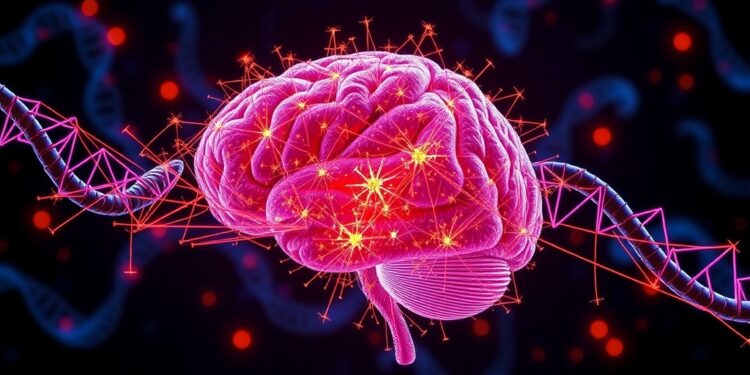Recent findings have revealed groundbreaking insights into the neurological underpinnings of autism and schizophrenia, particularly in children with 22q11.2 deletion syndrome. Researchers at UCLA Health have conducted an innovative study highlighting the developmental changes in brain connectivity that may significantly contribute to the elevated risk of developing these psychiatric disorders. This research has the potential to reshape our understanding of the biological causes behind these complex neurological conditions.
Understanding the connection between brain connectivity changes and developmental psychiatric disorders has long posed a challenge in neuroscience. Autism and schizophrenia, both multifaceted conditions, are associated with alterations in functional connectivity within the brain. The UCLA study specifically focused on the rare genetic disorder known as chromosome 22q11.2 deletion syndrome—characterized by missing genetic material on chromosome 22. This condition has been linked to an increased incidence of neuropsychiatric disorders, yet the biological mechanisms mediating this connection had remained elusive until now.
In a comprehensive analysis, researchers utilized functional brain imaging techniques to explore the differences in connectivity patterns in both genetically modified mice and human subjects diagnosed with the deletion syndrome. Their observations revealed a striking phenomenon. Prior to the onset of puberty, researchers noted that brain regions exhibited hyperconnectivity, indicating an overactive state where areas of the brain were excessively interconnected. This pattern starkly contrasts with the post-pubertal period, where a significant downregulation of connectivity occurred, particularly in regions of the brain associated with social abilities and autism.
Co-senior author Carrie Bearden, a prominent Professor at the Semel Institute and the UCLA Brain Research Institute, emphasized the importance of understanding these connectivity shifts at a synaptic level. According to Bearden, while differences in functional connectivity observed through MRI scans are frequently seen in individuals with psychiatric disorders, the underlying reasons for these variations have remained largely speculative. By studying both animal models and human patients, the research team has begun to illuminate the fundamental processes that drive these changes.
The study highlighted the role of dendritic spines, which are microscopic protrusions present on neurons facilitating synaptic communication. Bearden’s team discovered that younger mice with the deletion syndrome displayed a greater density of these dendritic spines compared to their normally developing counterparts. This increase suggests heightened synaptic connectivity during the developmental stage before puberty. However, as the genetically modified mice transitioned into the equivalent of puberty, a dramatic decrease in dendritic spine density was observed, indicating a loss of synaptic connections.
One of the pivotal proteins implicated in regulating synaptic dynamics is GSK3-beta. Through multidisciplinary approaches involving pharmacological interventions, the team was able to temporarily inhibit GSK3-beta, which led to a restoration of both dendritic spine density and brain activity in the affected mice. These findings suggest that the protein’s regulatory capabilities over synapse removal could be a key factor in addressing the connectivity changes that occur during puberty.
Moreover, when the research team examined human brains affected by the deletion syndrome, they discovered that similarly implicated brain regions demonstrated an enrichment of genes associated with GSK3-beta. This parallel reinforces the notion that alterations in synaptic connectivity are not only limited to animal models but are also relevant in the context of human neurodevelopment. Interestingly, the connectivity changes corresponded to behavioral assessments in humans, linking disrupted brain wiring to increased traits associated with autism.
The implications of these findings underscore the importance of synaptic health during critical periods of brain development, such as puberty. Understanding these dynamics may pave the way for novel therapeutic strategies aimed at addressing the specific connectivity disruptions that characterize chromosome 22q11.2 deletion syndrome. Bearden posits that intervening in synaptic dysfunction could potentially mitigate the behavioral challenges and neurodevelopmental disorders associated with this genetic condition.
Collectively, the research provides compelling evidence that excessive synaptic pruning—or "over-weeding"—during formative years may contribute to the behavioral and cognitive difficulties frequently observed in individuals with schizophrenia and autism. The revelation about significant connectivity shifts during pivotal developmental milestones such as puberty opens the door for further investigations into the potential for targeted interventions that could alter the trajectory of neurodevelopmental disorders linked to genetic predispositions.
Continued exploration in this area may ultimately lead to a refined understanding of how genetic factors interplay with neural connectivity to influence greater behavioral outcomes. As the scientific community builds upon these findings, future research will undoubtedly delve deeper into the mechanisms of synaptic regulation and their implications for psychiatric health, bolstering our efforts to unravel the complexities of developmental psychiatric disorders.
In conclusion, this groundbreaking study conducted by UCLA Health has illuminated previously uncharted territories regarding brain connectivity changes in children with chromosome 22q11.2 deletion syndrome. With interdisciplinary approaches and cutting-edge methodologies, the research offers hope not only for understanding the neurobiological undercurrents of autism and schizophrenia but also for paving the way towards future therapeutic advancements that could improve the lives of affected individuals and their families.
Subject of Research: Chromosome 22q11.2 deletion syndrome and its link to autism and schizophrenia.
Article Title: Synaptic-dependent developmental dysconnectivity in 22q11.2 deletion syndrome.
News Publication Date: 12-Mar-2025.
Web References: 10.1126/sciadv.adq2807.
References: (Information not provided).
Image Credits: (Information not provided).
Keywords: Autism; Human brain; Puberty; Behavior genetics; Schizophrenia; Mental health; Magnetic resonance imaging; Social research; Dendritic spines; Risk factors; Human development.




